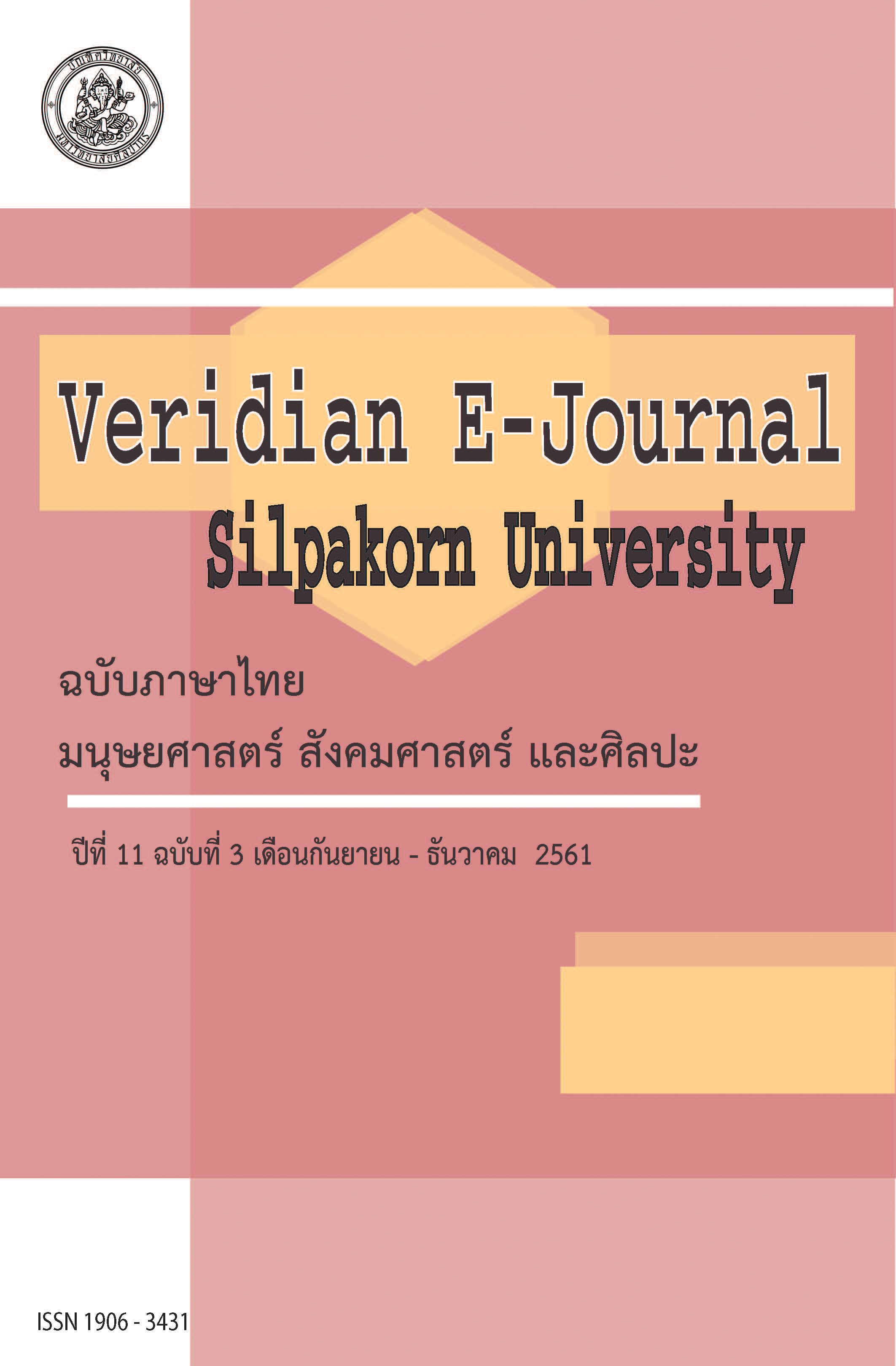ผลของการเรียนการสอนโดยใช้เทคนิคห้องเรียนกลับด้านร่วมกับกูเกิ้ล คลาสรูม ที่มีต่อความคงทนของความพร้อมในการเรียนรู้ด้วยตนเองและ ผลสัมฤทธิ์ในการเรียนในวิชาภาษาอังกฤษธุรกิจ (The Effect of Using Flipped Classroom Technique with Google Classroom on the Retention of the Students’ Self-Directed Learning Readiness and Achievement in Business English)
Main Article Content
Abstract
การวิจัยเรื่อง “ผลของการเรียนการสอนโดยใช้เทคนิคห้องเรียนกลับด้านร่วมกับกูเกิ้ลคลาสรูมที่มีต่อความคงทนของความพร้อมในการเรียนรู้ด้วยตนเองและ ผลสัมฤทธิ์ในการเรียนในวิชาภาษาอังกฤษธุรกิจ” เป็นการวิจัยเชิงทดลอง (Experimental research) มีวัตถุประสงค์ของการวิจัยคือ (1) เพื่อเปรียบเทียบผลสัมฤทธิ์ในการเรียนวิชาภาษาอังกฤษธุรกิจของนักศึกษา ก่อนและหลังการเรียนการสอนโดยใช้เทคนิคห้องเรียนกลับด้านร่วมกับกูเกิ้ล คลาสรูม (Google classroom) (2) เพื่อทดสอบความคงทนทางการเรียนวิชาภาษาอังกฤษธุรกิจของนักศึกษาก่อนและหลังการเรียนการสอนโดยใช้เทคนิคห้องเรียนกลับด้านร่วมกับกูเกิ้ล คลาสรูม (3) เพื่อเปรียบเทียบความพร้อมในการเรียนรู้ด้วยตนเองของนักศึกษาก่อนและหลังการเรียนการสอนโดยใช้เทคนิคห้องเรียนกลับด้านร่วมกับกูเกิ้ล คลาสรูม และ (4) เพื่อทดสอบความคงทนของความพร้อมในการเรียนรู้ด้วยตนเองของนักศึกษาก่อนและหลังการเรียนการสอนโดยใช้เทคนิคห้องเรียนกลับด้านร่วมกับ กูเกิ้ล คลาสรูม
การวิจัยครั้งนี้เป็นการวิจัยเชิงทดลอง (Experimental research) ในรูปแบบ Randomized Pretest-Posttest control group design ผู้เข้าร่วมการวิจัยประกอบด้วย นักศึกษาชั้นปีที่ 3 สาขาภาษาอังกฤษธุรกิจ มหาวิทยาลัยเอเชียอาคเนย์ กรุงเทพมหานคร ที่ลงทะเบียนเรียนวิชา ภาษาอังกฤษธุรกิจ1 ภาคเรียนที่ 1 ปีการศึกษา 2560 จำนวน 80 คน โดยผู้เข้าร่วมการวิจัยถูกแบ่งออกเป็น 2 กลุ่มเท่าๆ กัน คือกลุ่มควบคุม 40 คน และกลุ่มทดลอง 40 คน ผู้วิจัยทำการสุ่มผู้เข้าร่วมวิจัยเข้ากลุ่มโดยใช้การจับสลาก (Drawing) เครื่องมือที่ใช้ในการวิจัยได้แก่ บทเรียนรายวิชา 531210 ภาษาอังกฤษธุรกิจ 1 ในระบบกูเกิ้ล คลาสรูม แบบวัดผลสัมฤทธิ์ทางการเรียนรายวิชา 531210 ภาษาอังกฤษธุรกิจ 1 แบบทดสอบคู่ขนาน 2 ฉบับ และ แบบวัดความพร้อมทางการเรียนรู้ ( Self-directed learning readiness scale) การวัดผลทำก่อนและหลังการทดลอง และวัดความคงทนทางการเรียนหลังสิ้นสุดการวัดผลสัมฤทธิ์ทางเรียนไปแล้วเป็นเวลา 2 สัปดาห์ ผลการศึกษาสามารถสรุปได้ดังนี้ (1) นักศึกษาในกลุ่มทดลองมีค่าเฉลี่ยคะแนนทดสอบของวิชาภาษาอังกฤษธุรกิจ 1 หลังการเรียนการสอนด้วยเทคนิคห้องเรียนกลับด้านร่วมกับ กูเกิ้ล คลาสรูม สูงกว่าค่าเฉลี่ยของคะแนนทดสอบก่อนการเรียน (2) นักศึกษากลุ่มทดลองมีค่าเฉลี่ยคะแนนการทดสอบหลังการเรียนการสอนด้วยเทคนิคห้องเรียนกลับด้านร่วมกับ กูเกิ้ล คลาสรูม สูงกว่าค่าเฉลี่ยคะแนนทดสอบหลังการเรียนของนักศึกษากลุ่มควบคุม (3) ผลการศึกษาไม่พบความแตกต่างอย่างมีนัยสำคัญทางสถิติของค่าเฉลี่ยคะแนนการทดสอบในการวัดซ้ำของกลุ่มทดลองหลังสองสัปดาห์ (4) นักเรียนที่เข้าร่วมกลุ่มทดลองมีค่าเฉลี่ยของความพร้อมในการเรียนรู้ด้วยตนเองหลังจากการเข้าเรียนในห้องเรียนกลับด้านสูงกว่าก่อนเข้าเรียน (5) นักเรียนกลุ่มทดลองมีค่าเฉลี่ยของความพร้อมในการเรียนรู้ด้วยตนเองหลังจากการเข้าเรียนในห้องเรียนกลับด้านสูงกว่าค่าเฉลี่ยหลังการเรียนของกลุ่มควบคุม (6) ไม่พบความแตกต่างอย่างมีนัยสำคัญทางสถิติของค่าเฉลี่ยความพร้อมในการเรียนรู้ด้วยตนเองในการทำวัดซ้ำของกลุ่มทดลองหลังสองสัปดาห์
The research on “The Effect of Using Flipped Classroom Technique with Google classroom on the Retention of the Students’ Self-Directed Learning Readiness and Achievement in Business English”, has aimed to (1) compare the students’ achievement in Business English before and after learning with flipped classroom technique through Google classroom (2) test the retention of the students’ achievement in Business English after learning with flipped classroom technique through Google classroom. (3) compare the students’ self- directed learning readiness before and after learning with flipped classroom technique through Google classroom and (4) test the retention of the students’ self- directed learning readiness after learning with flipped classroom technique through Google classroom.
This study is an experimental research, using a randomized pretest-posttest control group design. The participants of this research comprised eighty of the 3rd year students who enrolled in Business English 1 course in the first semester of the year 2017. The participants were divided into two groups, 40 each. Drawing technique was used in randomly select members for each group. The tools employed in this research are the Business English 531210 lesson, installed in Google classroom system, achievement test and two parallel tests for the Business English lesson and self- directed learning readiness scales. The measurement of the outcome was executed before and after the experiment. Particularly the experimental group was being measured the retention, after the posttest 2 weeks. The result of the study can be concluded as follows; (1) The students in experimental group, had a higher mean value of the posttest on Business English subject than the mean value of the pretest. (2) The experimental students group also had a higher mean value of the posttest than that of the control group. (3) There was no statistical significant difference in the mean values of the test score among the repeated measurement of the experimental group after 2 weeks. (4) The students joining the experimental group had a higher mean value of self-directed learning readiness after participating in the flipped classroom than before. (5) They also had a higher mean value for self-directed learning readiness after participating in the flipped classroom than that of the students in the control group. (6) The finding also pointed out that there was no statistical significant difference in the mean values of the self-directed learning readiness among the repeated measurements of the experimental group after 2 weeks.
